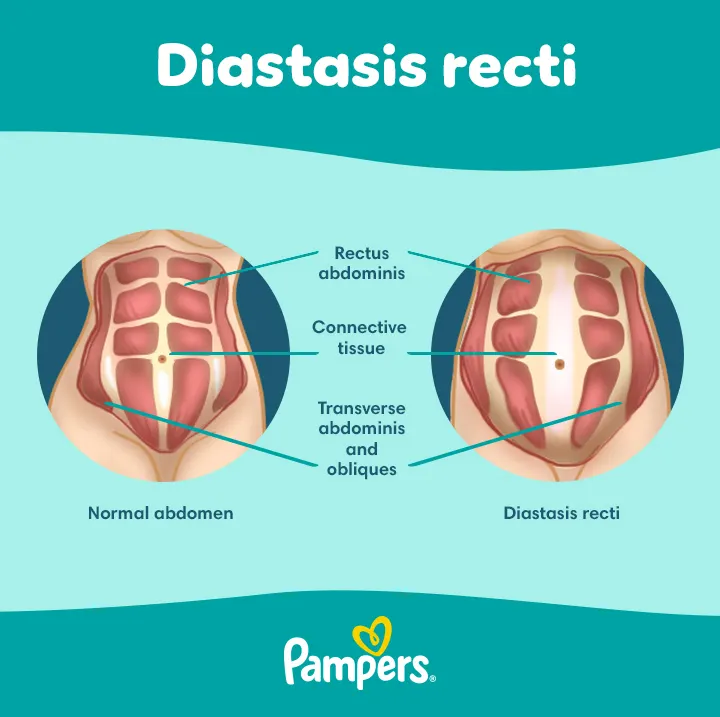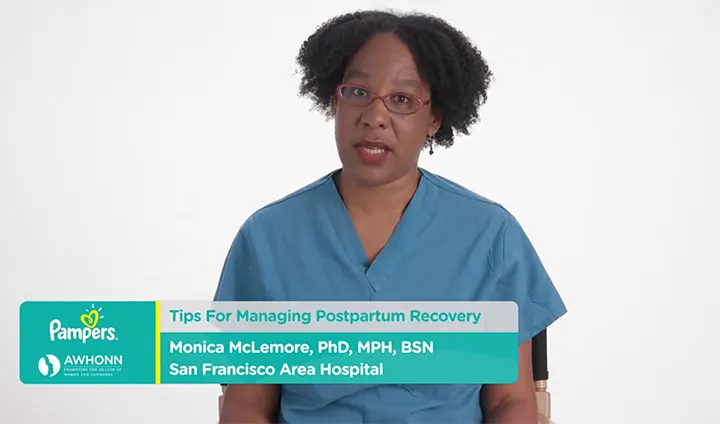Diastasis Recti: Abdominal Separation in Pregnancy
During pregnancy, your body can undergo various strange and fascinating changes. As your baby grows and your uterus expands, the muscles in your abdomen stretch. In some individuals, the rectus abdominis muscles may separate excessively, particularly toward the end of pregnancy or in the days and weeks following delivery. This condition is called diastasis recti. Continue reading to learn more about diastasis recti, its causes, how to determine if you have it, and potential treatment options, including exercises.
What Is Diastasis Recti (Abdominal Muscle Separation)?
Diastasis recti, more formally known as diastasis recti abdominis, is a condition in which the rectus abdominis muscles, commonly referred to as the six-pack muscles, separate from one another. This often occurs during pregnancy as the uterus expands, as well as in the first few weeks following childbirth, when the muscles may not return to their original position.
This vertical separation of the abdominal muscles might not be obviously visible before or after pregnancy due to your stretched abdomen, but after you give birth, you may notice a bulge in your abdomen when these muscles are tensed. For example, this bulge might show itself when you sit up from a lying position. Diastasis of the rectus abdominis muscles can sometimes lead to issues such as back pain. You can read more about healing after childbirth in our dedicated article.
Diastasis Recti Signs and Symptoms
Diastasis recti usually appears as a bulge in the middle of your abdomen where your rectus muscles have separated. This becomes apparent when you try to flex or tighten your abdominal muscles. It might not be immediately obvious that you have diastasis recti when you’re pregnant, or even immediately after. However, your healthcare provider might be able to detect it in your third trimester during a physical exam. As you lie on the exam table and gently flex your abdominal muscles, your provider may feel a separation. In some cases, an ultrasound may also be performed.
The condition itself is normally painless, but it can sometimes lead to some lower back pain during and after pregnancy or make it difficult to do everyday tasks that involve lifting things or bending in certain ways because the muscles have stretched and therefore weakened. As well as the visual symptoms we mention in the section below, you may also notice you have some urine leakage, especially when you cough or sneeze, pain during sex, or poor posture.
If, after delivery, you suspect you might have developed diastasis of the rectus abdominis, you can do a self-check before seeing your healthcare provider for a diagnosis.
Pregnancy Weight Gain Calculator
Fill out your details:
How to Check if You Have Diastasis Recti
So, how do you know if you have diastasis recti? Here is one method of checking for this condition:
Lie on your back with your knees bent, and gently raise your head and shoulders as if doing a gentle sit-up.
With your abdominal muscles flexed or squeezed in this position, you might feel a gap in the centre of your abdomen, somewhere between your pubic bone and your rib cage.
If you feel a gap that is wider than two finger widths (between the left and right rectus muscles), you might have diastasis recti.
What Does Diastasis Recti Look Like? Visual Signs
As we mentioned above, diastasis recti might not be obvious during pregnancy, but during the postpartum period you may notice:
A soft, gap-like feeling between the left and right sides of the rectus abdominis muscles
A ridge or bulge down the midline of the stomach, usually noticeable when straining or contracting the abdominal muscles
Difficulty with core strength, which may cause issues with posture, lower back pain, or balance
The stomach may form a domed or coned shape, especially when performing exercises like sit-ups or crunches.
You can check out our article on how a postpartum belly may look and feel after giving birth, but if you suspect you have diastasis recti, contact your healthcare provider for a diagnosis and treatment options.
Main Causes of Diastasis Recti (Abdominal Separation)
There isn’t a wealth of information about what exactly can cause this condition, but your pre-pregnancy weight and pregnancy weight gain are not thought to have much of an impact on whether or not you develop this condition if you’re in the normal BMI range.
But there are a few other factors that may make you more likely to develop diastasis recti:
Being pregnant with twins or other multiples
Giving birth to a particularly large baby (weighing more than nine and a half pounds at birth is considered above-average weight)
Being petite or having a small frame
Being older than 35.
Diastasis Recti Treatment Options
It’s important to remember that diastasis recti is a muscular condition that may or may not require treatment. If you’re diagnosed with diastasis recti, your healthcare provider may refer you to a physical therapist who will advise you on appropriate post-pregnancy exercises that can strengthen your ab muscles again, as well as provide a timeline for when you can start to exercise again after giving birth.
In rare cases, your healthcare provider may recommend surgery for your diastasis recti. Your provider will give you more personalized advice if physical therapy hasn’t fixed the problem.
Diastasis Recti and Exercise: Postpartum Exercises for Recovery
If you’re wondering how to heal diastasis recti with exercise, performing gentle exercises and movements that engage the abdominal muscles is recommended. It’s always best to follow your healthcare provider's and physical therapist's advice, but here are some recommendations for exercising to help treat your diastasis recti.
| Dos | Don’ts |
|---|---|
| Do focus on gentle core-strengthening exercises like pelvic tilts, diaphragmatic breathing, and heel slides to gently re-engage the abdominal muscles. | Don’t perform traditional abdominal exercises such as crunches, sit-ups, or bicycle movements (anything that causes your abdominals to bulge or dome). |
| Do engage the transverse abdominis (deep core muscles) with exercises like belly breathing or modified plank exercises. | Don’t lift anything heavier than your baby. |
| Do practice pelvic floor exercises (e.g., Kegels) to improve stability and support the core. | Don’t perform exercises such as planks and push-ups, and those used in yoga and Pilates like downward dog, double leg lifts, boat pose, and scissors. |
| Do roll onto your side and use your arms to push yourself up when getting out of bed. | Don’t ignore pain or discomfort during any exercise—stop immediately and consult your provider if needed. |
| Do maintain good posture throughout your daily activities to help reduce strain on your abdominal muscles. | Don’t skip core strengthening; even mild, consistent core exercises are crucial to healing. |
| Do be mindful of your daily movements and how you use your abdominal muscles. | Don’t rush your recovery by attempting high-impact exercises too early. |
How to Fix Diastasis Recti Years Later
The good news is, with some patience and consistency, you can heal your diastasis recti whether it’s shortly after giving birth or years later. As always, it’s best to consult your healthcare provider and get a suitable exercise plan from your physical therapist to start you on your healing journey. You can also follow some of our advice above on what to do and what not to do when it comes to diastasis recti and exercise.
Prevention of Diastasis Recti During Pregnancy
If you’re wondering how to prevent diastasis recti, there are some things you can do to help decrease your risk. During your pregnancy, you'll want to check with your healthcare provider before beginning or continuing any pregnancy exercise program. However, there are a variety of exercises you can do during pregnancy to help strengthen your abdominal muscles.
For example, with your provider’s OK, kneel on all fours and pull your ab muscles inward toward your back while inhaling and exhaling. Keep your back straight while doing this.
It’s also important to practice good posture and maintain a healthy body weight during your pregnancy. This helps alleviate some of the pressure that might lead to back pain as your belly grows. For more information on possible recommended weight gain ranges for various pre-pregnancy BMIs, try our Pregnancy Weight Gain Calculator and chat with your healthcare provider.
Kegel exercises can also help prevent or alleviate the back pain that may be associated with diastasis recti and can possibly help with other issues you may experience before and after delivery, such as any urinary or bowel incontinence or painful sexual intercourse.
If you’re not familiar with Kegels, here's what to do: simply squeeze the pelvic floor muscles as if you were trying to stop a flow of urine. Hold for about 3 to 10 seconds (you can work your way up to 10 seconds over time), and then release. Build up the number of repetitions you do until you can do about 10 or 20 repetitions at a time, a few times a day. Your healthcare provider can help you master Kegels, so ask for help if you need it. Done regularly over time, Kegels can help you build the strength of your pelvic floor muscles, and this may help relieve some of the associated symptoms of diastasis recti. And the best thing—you can do Kegel exercises anywhere—even when you’re watching TV!
The Bottom Line
You’ll no doubt be amazed at what your body has achieved over the past several months as you hold your newborn baby. It’s impressive, and you should be proud. Still, over time, you’ll become familiar with your post-baby body and the ways it has changed.
If you think you might have diastasis recti (separation of the abdominal muscles), check in with your healthcare provider for specific advice and exercises to help these weakened muscles get stronger. Be patient with yourself and your body, and give yourself the time to deal with this abdominal muscle separation and to heal and recover from childbirth.
How We Wrote This Article The information in this article is based on expert advice found in trusted medical and government sources, such as the American Academy of Pediatrics and the American College of Obstetricians and Gynecologists. You can find a full list of sources used for this article below. The content on this page should not replace professional medical advice. Always consult medical professionals for full diagnosis and treatment.
Join Pampers Club and get:







